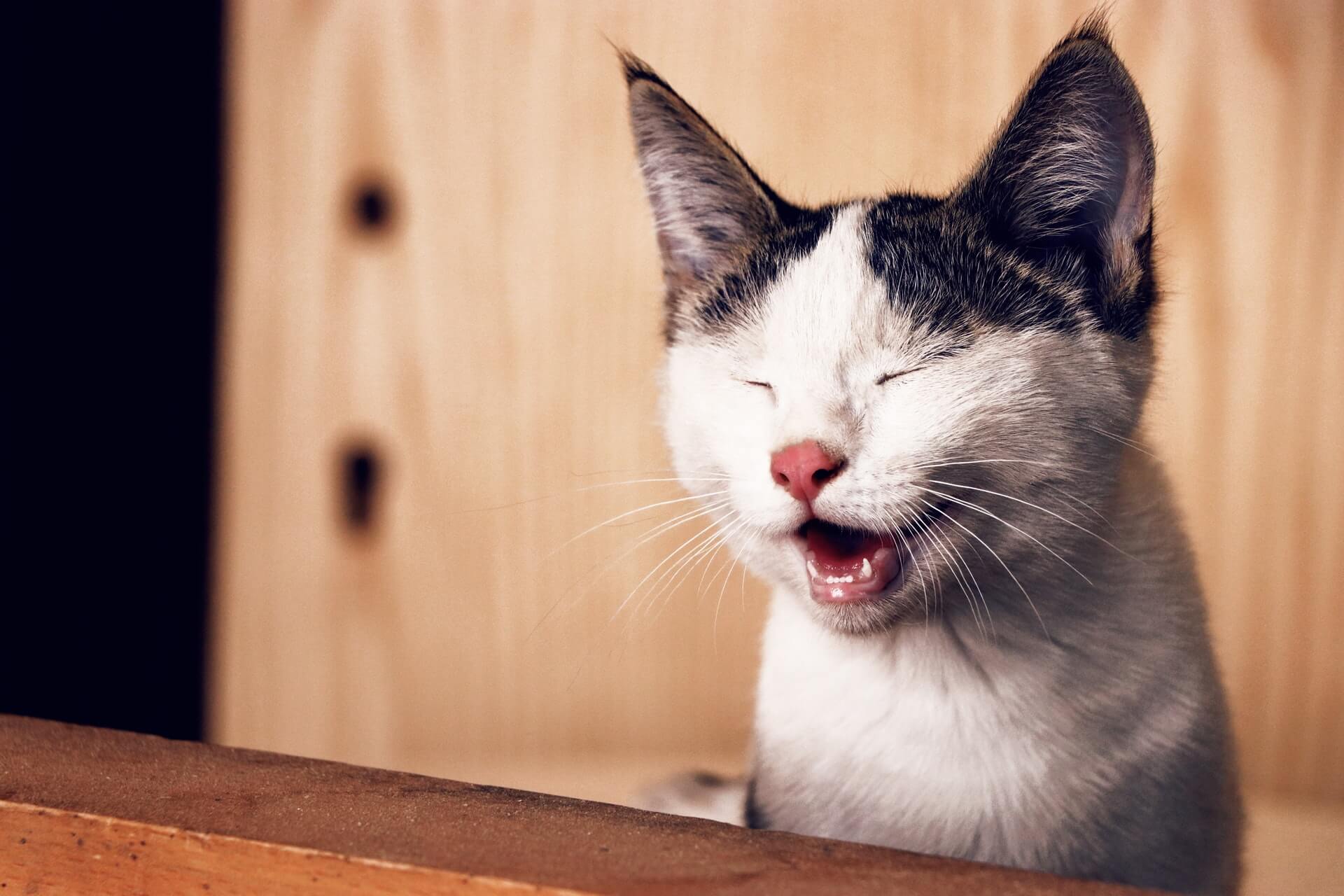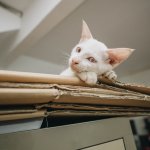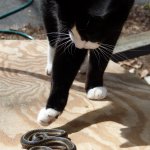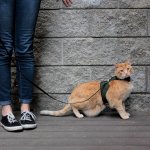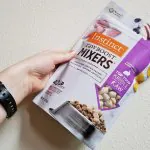The Truth About Raw Cat Food and Constipation
Last Updated on
You’re not crazy. There really is a connection between raw cat food and constipation. We’re often told that if you think your cat is constipated on a raw diet, you’re just confused by the fact that raw-fed cats have smaller, less smelly stools than those on high-waste diets. In reality, commercial or homemade raw cat food is often deficient in the indigestible matter that very likely helps stool to retain water and move through the GI tract.
Is your cat constipated on a raw diet?
Smaller, drier stools are a normal part of a raw-fed cat’s life, but constipation is something different.
When people say they think their raw-fed cat might be constipated, they’re often told that they just don’t know what a healthy cat’s poo looks like. While it’s true that a raw-fed cat’s poo looks a little different than the feces of a cat who eats a high-waste diet, it’s important to remember that it is possible and even likely for a raw fed cat to be constipated.
It’s important to understand the symptoms of constipation in cats so that you’ll know the difference between a healthy raw-fed cat who just doesn’t have much waste and a cat who is suffering from serious constipation.
How do you know if your cat is constipated?
People will tell you that your cat should defecate daily, but it’s not quite that hard-and-fast. Even the Continence Foundation of Australia acknowledges that bowel health is more than just having a bowel movement every day. When asked to define regularity, they said that “Being regular really means that soft yet well-formed bowel motions are easily passed and that this happens anywhere from 1–3 times a day to 3 times a week.”
Essentially, if your cat seems comfortable in the litter box and their stool is within the healthy range on the Bristol Stool Chart, they probably aren’t constipated. In case you need a reminder, the healthy stool consistency range is between 3 and 4 on the Bristol Stool Chart.
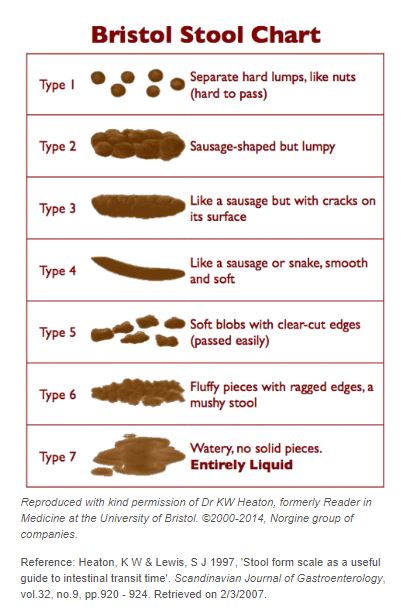
Source: Continence.org.au
Again, it’s normal for raw-fed cats to have smaller, firmer stools than cats on other diets.
If your cat is behaving normally and seems to feel well, fecal changes after switching to a raw diet are usually no reason for concern. In case you’re still not sure if your cat’s poo looks normal, take a look at this video from the Feline Nutrition Foundation.
About Constipation and the GI Tract
Think about your cat’s GI tract. Yes, it’s a tube running from your cat’s mouth to their anus, but it’s also more than that.
The gastrointestinal tract is an incredibly complex system composed of bacteria, yeasts, a maze of intestines, connection to the rest of the body via bustling capillary transit routes, many other intricate structures. All of these systems must work together to process nourishment and move waste out of your cat’s body.
Though the digestive tract has many segments, we’re primarily concerned with what happens in the colon, because that’s where constipation starts. When waste arrives in the colon, it’s in the form of a sludge called chyme. The colon must draw water out of this sludge, ideally taking just enough time to reduce it to the…uh…cookie dough consistency…that we consider healthy.
If for some reason, the chyme hangs out in the colon for too long, it will continue to dehydrate beyond the sweet spot, becoming smaller and harder and sticking around as new chyme enters. This situation is called constipation.
Our goal is to figure out why the digestive flow was disrupted and how we can counteract that effect.
Reasons Your Raw-Fed Cat Might be Constipated
Your cat’s raw diet is too digestible.
Ultimately, no diet is 100% digestible and bioavailable. If it was, there would be no such thing as poo. What a world, right? Instead, we have foods with varying degrees of biological availability. For obligate carnivores like our cats, raw meat and eggs are upwards of 80% bioavailable. Ingredients like pea protein lie at the opposite end of the spectrum.
While we usually praise foods for being highly digestible and, indeed, most foods on the market are not nearly as efficient as they should be, don’t overlook the significance of indigestible food matter.
As far as constipation is concerned, the most significant difference between a human-formulated whole prey diet and actual whole prey is that the real prey has feathers and fur.
As earnestly as people try to create species-appropriate whole prey raw cat food, most miss an important detail—the nutritionally devoid portion of the prey animal. Therefore, homemade or commercially-sold raw diets are extremely efficient, delivering almost pure nutrition with very little waste left over.
This lack of indigestible matter can contribute to constipation. If you suspect that your cat’s food is too clean, you may help them out by introducing a small amount of fiber into their diet. You may do this by giving them a pot of cat grass to nibble on, adding a little psyllium husk powder to their diet, or by giving small amounts of guar gum.
Your cat’s raw food contains too much bone.
Many raw cat foods, particularly commercially-sold products, contain more bone than is necessary. It’s generally agreed that species-appropriate foods follow the 83: 7: 5: 5 rule, indicating 83% meat, fat, skin, sinew, connective tissue, and heart, 7% edible bone, 5% liver, and 5% other secreting organs.
When making or purchasing raw cat food, pay attention to your ratios of meat, organs, and bone. While it’s normal for some bone to appear in a raw-fed cat’s stool, excessively bone-rich food could lead to dry, crumbly feces and constipation.
Other Causes of Constipation in Cats
Obesity and/or Inactivity
Exercise stimulates peristalsis, which is another word for the GI contractions that push stool from your cat’s colon towards outlet. Cats who don’t exercise much may simply not get the signal, leading to waste that remains in the body for too long, becomes dehydrated, and doesn’t leave the body for days or weeks at a time. Encourage your cat to play every day.
Physical Obstructions
Sometimes constipation is caused by a physical obstruction. Your cat may have eaten something that’s now blocking the flow of waste out of their body. If your cat has severe constipation accompanied by vomiting, lethargy, and other symptoms of distress, they may have a physical obstruction. This is a justification for a vet visit.
Litter Box Avoidance
Sometimes, cats boycott a dirty litter box long enough to allow the stool to start hardening in the colon, turning into hard-to-pass pebbles. If your cat’s constipation is associated with a dirty litter box, you obviously need to re-evaluate your approach to litter box cleanliness.
Cat Constipation Home Remedy and Treatment
Add fiber or indigestible animal matter to your cat’s diet.
Cats don’t need fiber, but if they are constipated, adding a little indigestible plant matter can help. Just remember that there are two types of fiber—insoluble and soluble fiber. The two types of fiber can help cats with constipation in different ways.
Insoluble fiber is used as a bulking agent. If your cat’s stool is small, hard, and doesn’t create enough pressure to trigger a bowel movement, added insoluble fiber may be able to help.
Soluble fiber has an interesting effect on constipated cats. It’s prebiotic, meaning that it fuels probiotic activity in the gut. The living organisms in your cat’s gut will consume the prebiotic fiber, then release short-chain fatty acids as a by-product. These fatty acids create a slightly acidic environment, which helps the stool to retain more water.
Here are a few fiber supplements you can give your cat if they’re suffering from constipation:
- Psyllium husk powder
- Chia seeds
- Ground flaxseeds
- Powdered cellulose
- Green beans
- Cat grass
- Catnip
Aloe Vera Juice
Aloe vera juice, not aloe vera gel for sunburns, is a gentle laxative. You can add ½ tsp to your cat’s food to gently get the feces moving again. Aloe vera juice can give cats diarrhea and you may want to ask your veterinarian for their thoughts before giving it to your cat.
Slippery Elm Bark Powder
This powder is an anti-inflammatory commonly used to treat multiple types of GI problems. It’s as good for diarrhea as it is for constipation. The powder lubricates and soothes the digestive tract, and because it’s a bark-based powder, is rich in fiber. It’s recommended that you give your cat 100mg slippery elm bark powder per 10 lbs of body weight. Mix the powder with cold water to create an easy-to-eat gruel.
If the constipation is severe, your veterinarian may need to clear the plumbing.
Sometimes constipation is so bad that your veterinarian will prescribe an enema for your cat. This will clear out the waste, but it won’t solve the underlying problem. If possible, work with your veterinarian to identify the cause of your cat’s constipation.

